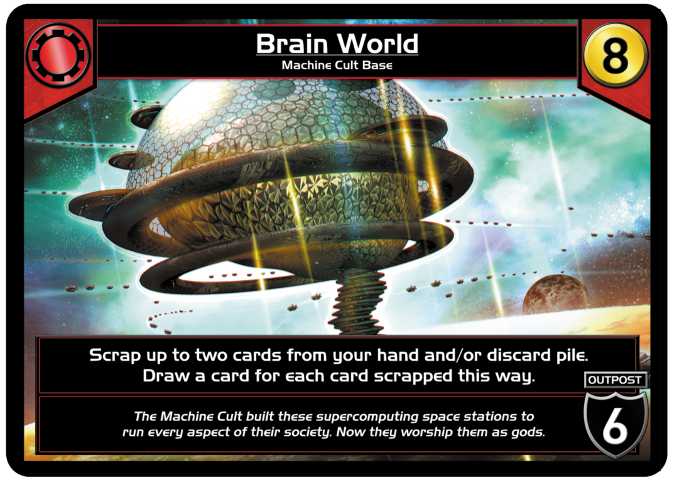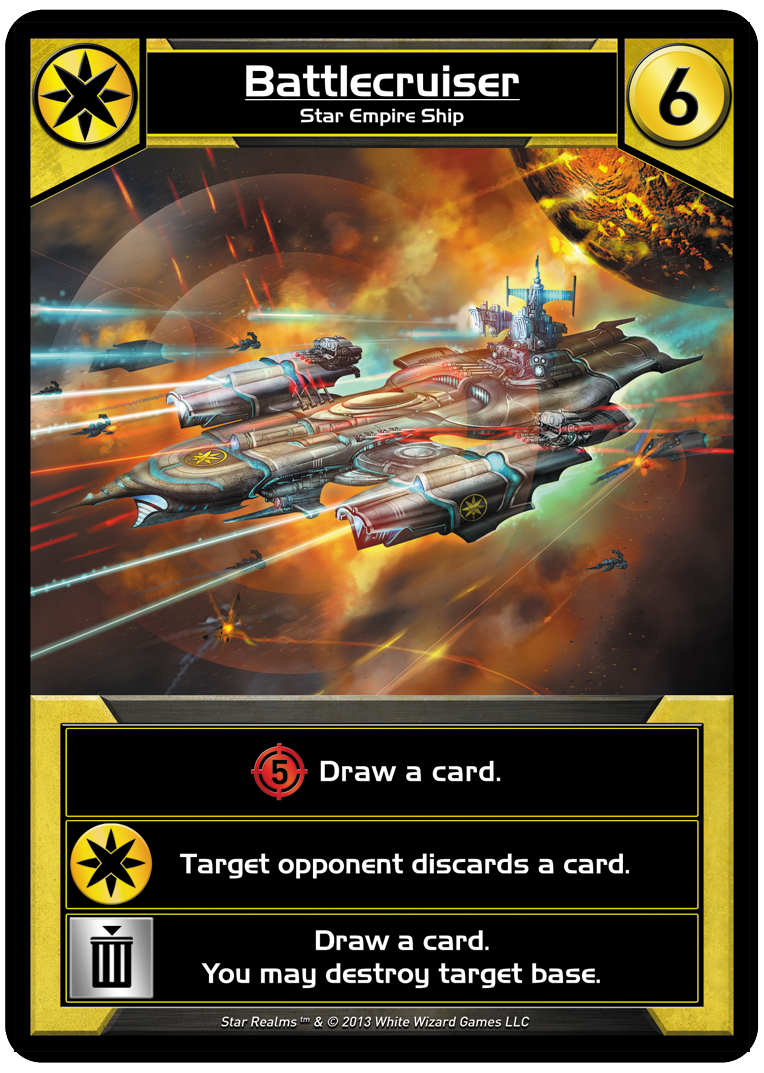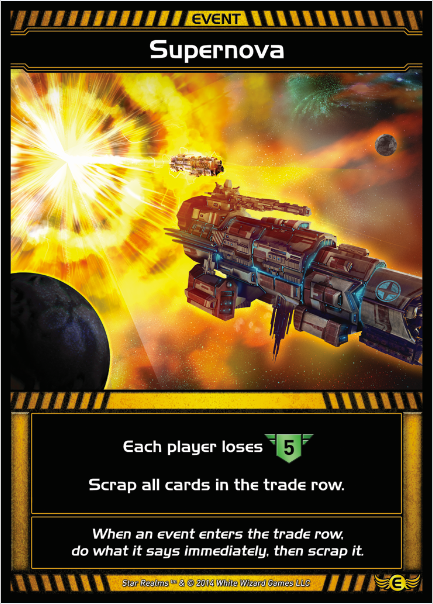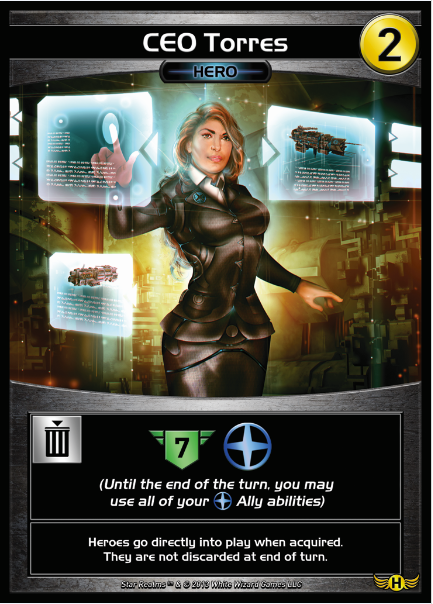Dominion was the first deck builder that I ever played. It was a really exciting game concept to me: I'd never really seen such an interesting blend of choice and randomness, and it got me hungry to see the extent of the deck builder genre. I had some complaints about Dominion, and my next excursion was into the world of Ascension, which I found more enjoyable. The addition of the market row added another layer of interaction that Dominion lacked.
But I'm not here to talk about those games, I'm here to talk about
Star Realms, and why it's my new favorite deck builder.
Designed by Darwin Kastle (Magic Hall of Famer and teacup planetary annihilator designer) and Rob Dougherty (Ascension Co-founder) Star Realms was created with the express goal of overcoming the non-interactivity of other deck builders, and it succeeds with style.
When I spoke to Kastle at his PAX East '15 booth, he broke down the core design philosophy to me. Winning in other deck builders often felt very arbitrary, either when a certain pile runs out or some other random timer mechanism ticks down. In order to create a more natural and climactic win, the goal in Star Realms is to blast your opponent to death. Star Realms is fairly simple mechanically, with each card offering purchasing power to get more cards, or attack power to destroy your opponent's star bases and life points.
The real depth comes from the ally mechanic. Each of the four factions rewards you for playing with more in-faction cards. The Blobs can do massive damage and chain together card draws for powerhouse turns. The Trade Federation keeps you in the game longer by boosting your life total and letting you buy more efficiently than the other factions. The Star Empire attacks your opponent directly with high damage ships and hinders their progression by making them discard cards. My favorite is the Machine Cult, which focuses on stripping out the chaff from your own deck so you have a purring engine of high impact cards that never wastes a turn. When you trigger the ally abilities of your faction you drastically increase the effectiveness of each card for a very satisfying boost in power.

If you don't think that is just the best thing, then get out of my house.
Playing the game is quick and easy. Each faction meshes well both mechanically and thematically, and you can always find good cards to splash. Because of the sheer volume of unique cards in the game you can play the same faction two or three games in a row and it doesn't feel like the same deck. There's a lot of interplay and decision making in each turn, but it doesn't gets bogged down in deliberation or minutiae. As you buy up cards new ones are revealed in the trade row for either yourself or your opponent to purchase.

The Empire mercilessly grinds out your opponent's ability to play. They look damn good while doing it, too.
The trade row mechanic is something that increases the interactivity of the game in an oblique manner. Buying out cards denies them to your opponents, but it reveals new cards for their perusal. The same mechanic is found in Ascension, so it isn't groundbreaking, but the Crisis expansion packs play with it in a really interesting way: They introduce events that trigger as soon as they come into the trade row, adding another element of randomness to the game. If you prefer to keep it more strictly skill focused, though, you can always leave them out of the deck.
These events impact the game in powerful ways, maybe giving each player extra cards or allowing them to gain some life points. Or this:

The other two packs in the Crisis cycle add more ships and bases that help balance out the core set by adding new cards that delve into unexplored design spaces within each faction. Plus, a bigger card pool of course means more variety between games. The final Crisis pack adds Heroes, cheap one-shot folks that temporarily trigger your ally abilities. Since most cards are sent to the discard pile when purchased, the fact that the heroes come right into play means you can use them for some more fancy flourishes to help your off-faction splashes function more effectively. Plus there is a sense of instant gratification in using them, and they don't gum up your deck later since it's a single use card.

The Trade Federation can buy and sell anything.
The flavor of this game is really stellar. The art on each card is engaging and the style is uniform, lending a sense of visual coherence to each faction and the universe as a whole. The inspiration of each faction is varied without feeling forced and artificial. Flavor text supports and builds the narrative of the world. If White Wizard produced a tabletop RPG based in the Star Realms universe, I would play it in a heartbeat.
Overall I feel that Star Realms hits all the right notes a deck builder needs. It builds on the successful concepts of previous games while incorporating ideas from other media to craft a satisfying and fun gaming experience that's chock full of character. Plus, it's only about fifteen bucks and offers a ton of replayability. Pick up the expansion boosters and you'll find yourself playing this game for a long time.
Check out Star Realms here. They also have a digital version that I haven't gotten to play, but it's probably just as great as the paper version. If you want to talk to me about our Machine Cult overlords, hit me up @DKjolner. When our Patreon starts bringing in enough money we'll be able to afford our own teacup planet buster. It's like if the Death Star were the size of a Roomba.
Writer
My favorite games involve lying to my friends. Usually this means running a tabletop RPG for them, but sometimes it means being the betrayer in a board game, or using rude tricks to make my opponents hit each other while I twirl a cartoonishly outsized mustache and cackle. If you like any combination of lying, storytelling, outsmarting your opponents, or tying helpless victims to train tracks, you might like some of my writing on games.
My favorite games involve lying to my friends. Usually this means running a tabletop RPG for them, but sometimes it means being the betrayer in a board game, or using rude tricks to make my opponents hit each other while I twirl a cartoonishly outsized mustache and cackle. If you like any combination of lying, storytelling, outsmarting your opponents, or tying helpless victims to train tracks, you might like some of my writing on games.